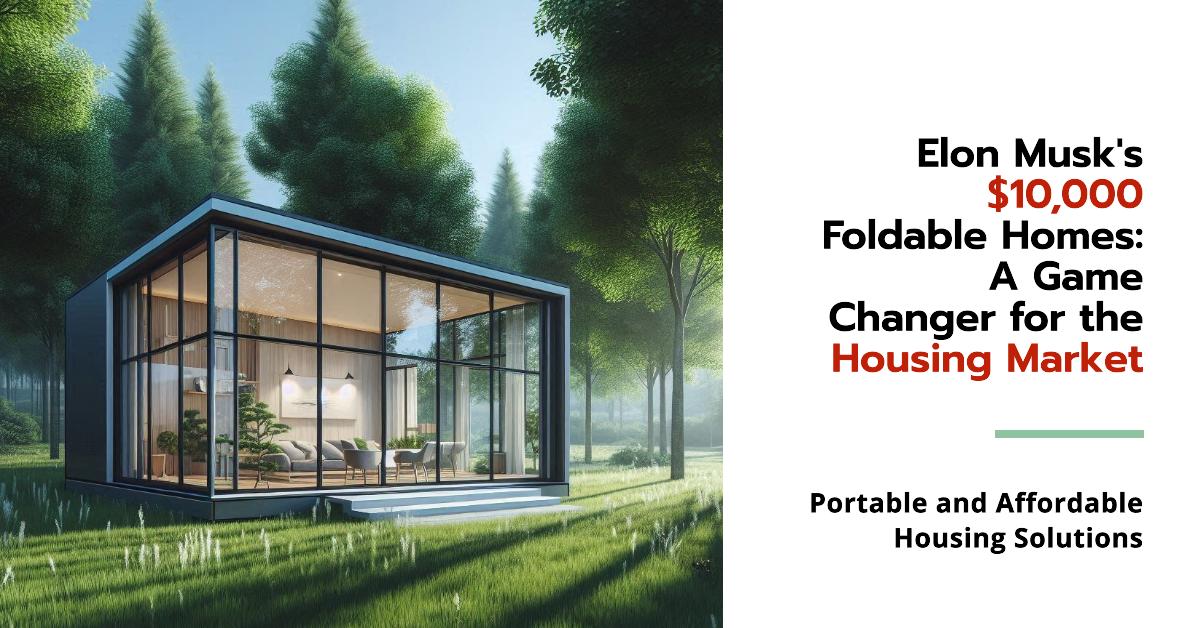
The internet is abuzz about Elon Musk’s introduction of $10,000 homes. If made possible, it can mark more than just an effort to provide cheaper housing options; it will embody a pioneering approach aimed at tackling one of society’s most pressing challenges: affordable housing in the United States.
With housing prices soaring and wages stagnating, many struggle to make ends meet. Musk’s plan for these homes suggests a radical shift in how we think about home ownership, making it accessible for first-time buyers and those living in financial uncertainty.
By redefining affordability, these homes may not only lay the groundwork for a more sustainable living model but also set the stage for transformative changes within the housing market.
Can Elon Musk Actually Offer $10,000 Affordable Modular Homes?
Key Takeaways
🏘️ Affordable Housing
Addresses the ongoing affordable housing crisis
🌿 Sustainable Living
Prioritizes environmental sustainability and energy efficiency
🏭 Prefabricated Design
Built via factory production, resulting in cost and time savings
📊 Market Impact
Could reshape broader housing market trends for the better
Innovative housing solutions paving the way for a more sustainable and affordable future
The Vision Behind Musk’s Affordable Homes for Americans
Elon Musk is best known for his revolutionary ideas in technology, transportation, and space. With ventures such as Tesla and SpaceX, he has changed the way we understand electric vehicles and rocket travel. Now, he’s bringing that innovative vision to housing through a partnership with Boxabl, a company that specializes in building affordable, modular homes.
The Boxabl Casita is at the forefront of Musk’s housing dream. Designed to be quick and easy to assemble, these compact homes are constructed from sturdy materials, conforming to high efficiency standards to ensure durability and longevity.
So, what is the actual cost of the Casita model which includes a Full-Size Kitchen, Bathroom, and Living Space?
According to Boxabl, the price point of Casita starts at $60,000, which stands in stark contrast to the conventional housing market’s soaring prices, which often exceed $300,000.
In addition to the Casita itself, there are other various project costs associated with the installation. The total cost of the project can vary based on a number of factors including your state, jurisdiction, site preparation, and complexity of installation.
This commitment to affordability serves as a loud message: homeownership shouldn’t be an exclusive privilege but a reachable goal for many.

The Current Economic Landscape: A Housing Market in Crisis
The challenges facing the housing market are numerous and complex, contributing to an ongoing crisis of affordability. Factors impacting the market include:
-
Rising Interest Rates: Recent years have seen the Federal Reserve’s adjustments leading to rising mortgage rates. As loans become more expensive, many potential homeowners find themselves priced out of the market.
Escalating Material Costs: A significant increase in the price of building materials—sparked by the COVID-19 pandemic and supply chain disruptions—has compounded the challenges for new home construction. Lumber, steel, and concrete prices have reached historic highs.
Skilled Labor Shortages: The construction industry faces a labor shortage, with many skilled workers retiring and fewer young workers entering the trade. This has slowed housing production and exacerbated supply issues.
Inflation Pressures: Broader economic inflation affects consumers in every sector, contributing to rising costs of living while wages remain stagnant, thus limiting consumer purchasing power.
Against this backdrop, it becomes clear why Elon Musk’s initiative to create affordable living options is so significant. His vision addresses fundamental economic disparities while working towards expanding homeownership opportunities for more individuals and families.
Sustainable Living: A Focus on Environmental Responsibility
As we move through an era increasingly defined by climate concerns and rising awareness of environmental issues, sustainability becomes a paramount consideration. Musk’s homes are designed with this in mind, striving to promote environmentally friendly living.
-
Energy-Efficient Systems: The homes can be equipped with high-efficiency appliances, low-flow fixtures, and advanced insulation, all aimed at reducing energy consumption and minimizing monthly utility bills. This means that residents can save money while still being environmentally conscious.
Solar Integration: One of the most appealing aspects of the Boxabl concept is the potential for solar energy. With solar panel installations, homeowners could even achieve net-zero energy usage, generating as much energy as they consume, which aligns seamlessly with Musk’s vision at Tesla of creating energy-efficient solutions for everyday living.
Minimal Waste Production: The prefabricated nature of these homes means they can be created with less waste compared to traditional construction methods. This strengthens the argument that new developments can be more sustainable without compromising quality or effectiveness.
A shift toward sustainable living spaces is not only beneficial for the Earth but also aligns with the values of many prospective buyers who wish to leave a lighter footprint on the planet. The market is starting to reflect this growing demand for eco-friendly solutions, further bolstered by Musk’s dedication to this cause.
Potential Market Impact of Musk’s Housing Initiative
Elon Musk’s $10,000 homes could have a transformative effect on the current housing market. While the benefits seem apparent, we can foresee several areas where these homes could lead to significant changes.
Increased Competition: The introduction of affordable homes into a saturated market could inspire other builders to innovate, either by optimizing their cost structures or by differentiating their products. Traditionally, the competition has concentrated around luxury homes and high-end features; introducing economically viable options can force mainstream builders to adjust their strategies.
Consumer Behavior Shifts: As potential buyers grow increasingly aware of affordable options, a trend may emerge wherein consumers actively seek out smaller, less traditional homes as primary residences. The minimalist movement is already gaining momentum and could be accelerated by the success of these homes.
Government Intervention and Support: Policymakers may feel pressured to create programs and incentives that favor innovative housing solutions, including financial incentives for developers to build affordable housing and zoning modifications to accommodate new types of housing projects. With growing grassroots support for affordable housing initiatives, there could be significant shifts at the governmental level, allowing Musk’s project to gain traction.
Defying Challenges: A Pragmatic Approach
While Musk’s affordable homes promise substantial opportunities, several challenges must be addressed to ensure their successful uptake:
-
Zoning Regulations: Most states have strict zoning laws that can hinder the construction of tiny homes. Navigating these regulations will require strategic collaboration between Musk’s team and government entities to bring these homes to various markets.
Social Norms and Expectations: By and large, society has been conditioned to associate homeownership with larger properties that offer more space and amenities. Overcoming this entrenched mindset signifies a cultural shift regarding home definition and value.
Financing Structures: Many banks and lending institutions may hesitate to provide loans for prefabricated homes. Establishing financing solutions tailored specifically for these houses is essential for bridging the gap between potential buyers and this groundbreaking housing option.
Market Saturation Risks: If too many of these homes flood the market, there is potential for oversaturation. This could decrease property values if poorly managed. Planning and timing will be crucial in the rollout of such an initiative.
Elon Musk’s $10,000 Homes: A Broader Perspective
Musk’s plans for affordable housing go beyond mere economics. They represent a philosophical shift towards inclusivity and adaptability in our current living standards. The proposed affordable homes may foster not only new community dynamics but possibly even a new lifestyle.
Community Cohesion: Smaller homes may encourage the formation of tight-knit communities where residents can enjoy shared experiences, fostering interactions among neighbors that larger homes often do not facilitate. This idea harkens back to simpler times and community-oriented living.
Emphasis on Minimalism: As societal values shift toward prioritizing experiences over possessions, embracing a minimalist lifestyle can meet both desires for sustainability and frugality. Achieving this with Musk’s homes could inspire more individuals to reconsider what they truly value in life.
Conclusion
Elon Musk’s affordable homes present an innovative approach to tackling issues surrounding the housing crisis, interweaving affordability, sustainability, and cutting-edge design within a compact living space. As we navigate ongoing challenges in the housing market, Musk’s initiative encourages a reevaluation of our existing systems and pushes us toward embracing new, inclusive models of living. By making a bold statement through affordable, eco-friendly housing, Elon Musk may very well influence how future generations view homeownership—where access and community are prioritized over mere size and prestige.
FAQs
1. What is the actual price of these homes?
The base price for the Casita model is $60,000, not $10,000. In addition to the Casita itself, there are other various project costs associated with your installation.
2. How are these homes built?
The homes are prefabricated using a modular design, allowing for quicker and more cost-effective construction.
3. How are these homes environmentally friendly?
The homes are designed with features like energy-efficient appliances, low-flow fixtures, and potential solar panel integration to minimize energy consumption and waste production.
4. How could these homes affect the housing market?
The introduction of affordable homes could increase competition, forcing traditional builders to adapt and potentially leading to more consumer interest in smaller, more sustainable living spaces. Additionally, government policies might shift to support such innovative housing solutions.





